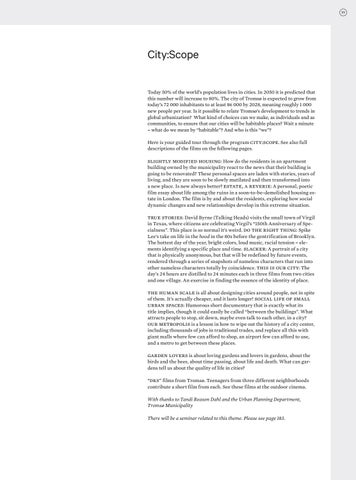77
City:Scope Today 50% of the world’s population lives in cities. In 2050 it is predicted that this number will increase to 80%. The city of Tromsø is expected to grow from today’s 72 000 inhabitants to at least 86 000 by 2028, meaning roughly 1 000 new people per year. Is it possible to relate Tromsø’s development to trends in global urbanization? What kind of choices can we make, as individuals and as communities, to ensure that our cities will be habitable places? Wait a minute – what do we mean by “habitable”? And who is this “we”? Here is your guided tour through the program city:scope. See also full descriptions of the films on the following pages.
slightly modified housing: How do the residents in an apartment building owned by the municipality react to the news that their building is going to be renovated? These personal spaces are laden with stories, years of living, and they are soon to be slowly mutilated and then transformed into a new place. Is new always better? estate, a reverie: A personal, poetic film essay about life among the ruins in a soon-to-be-demolished housing estate in London. The film is by and about the residents, exploring how social dynamic changes and new relationships develop in this extreme situation. true stories: David Byrne (Talking Heads) visits the small town of Virgil in Texas, where citizens are celebrating Virgil’s “150th Anniversary of Specialness”. This place is so normal it’s weird. do the right thing: Spike Lee’s take on life in the hood in the 80s before the gentrification of Brooklyn. The hottest day of the year, bright colors, loud music, racial tension – elements identifying a specific place and time. slacker : A portrait of a city that is physically anonymous, but that will be redefined by future events, rendered through a series of snapshots of nameless characters that run into other nameless characters totally by coincidence. this is our city: The day’s 24 hours are distilled to 24 minutes each in three films from two cities and one village. An exercise in finding the essence of the identity of place.
the human scale is all about designing cities around people, not in spite of them. It’s actually cheaper, and it lasts longer! social life of small urban spaces: Humorous short documentary that is exactly what its title implies, though it could easily be called “between the buildings”. What attracts people to stop, sit down, maybe even talk to each other, in a city? our metropolis is a lesson in how to wipe out the history of a city center, including thousands of jobs in traditional trades, and replace all this with giant malls where few can afford to shop, an airport few can afford to use, and a metro to get between these places. garden lovers is about loving gardens and lovers in gardens, about the birds and the bees, about time passing, about life and death. What can gardens tell us about the quality of life in cities? “dks” films from Tromsø. Teenagers from three different neighborhoods contribute a short film from each. See these films at the outdoor cinema. With thanks to Tandi Reason Dahl and the Urban Planning Department, Tromsø Municipality There will be a seminar related to this theme. Please see page 183.
















